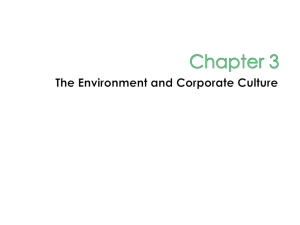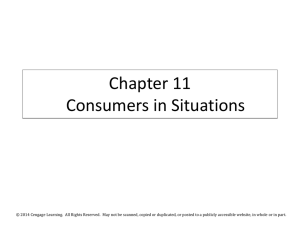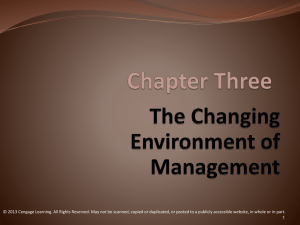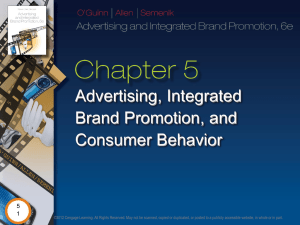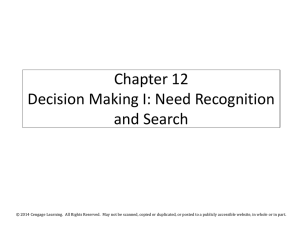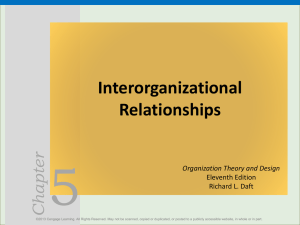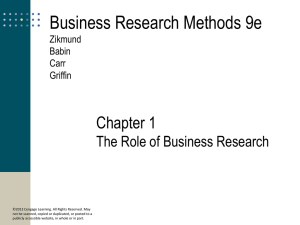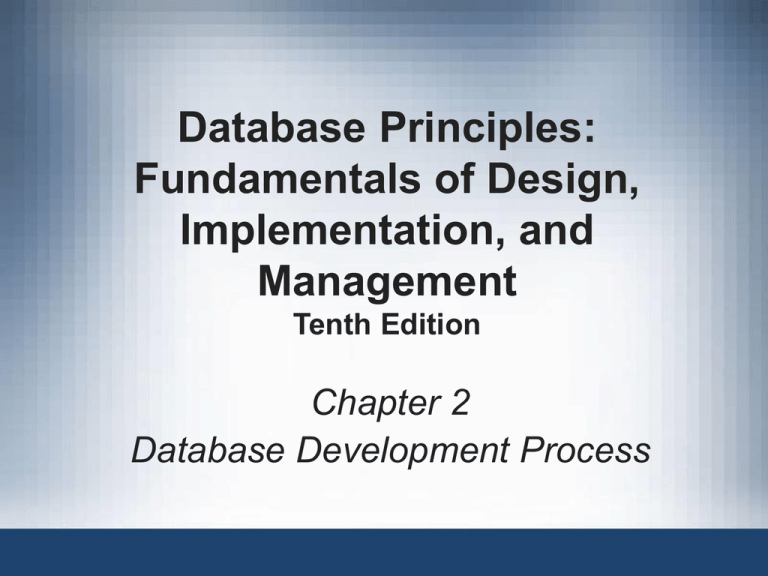
Database Principles:
Fundamentals of Design,
Implementation, and
Management
Tenth Edition
Chapter 2
Database Development Process
Objectives
• In this chapter, you will learn:
– That successful database design must reflect
the information system of which the database is
a part
– That successful information systems are
developed within a framework known as the
Systems Development Life Cycle (SDLC)
2
© 2013 Cengage Learning. All Rights Reserved. This edition is intended for use outside of the U.S. only, with content that may be different from the U.S. Edition.
May not be scanned, copied, duplicated, or posted to a publicly accessible website, in whole or in part.
Objectives (cont’d.)
– That within the information system, the most
successful databases are subject to frequent
evaluation and revision within a framework
known as the Database Life Cycle (DBLC)
– How to conduct evaluation and revision within
the SDLC and DBLC frameworks
– About database design strategies: top-down vs.
bottom-up design and centralized vs.
decentralized design
3
© 2013 Cengage Learning. All Rights Reserved. This edition is intended for use outside of the U.S. only, with content that may be different from the U.S. Edition.
May not be scanned, copied, duplicated, or posted to a publicly accessible website, in whole or in part.
The Information System
• Provides for
– data collection,
– storage, and
– retrieval
• Composed of:
–
–
–
–
–
–
People,
hardware,
software
Database(s),
application programs,
procedures
4
© 2013 Cengage Learning. All Rights Reserved. This edition is intended for use outside of the U.S. only, with content that may be different from the U.S. Edition.
May not be scanned, copied, duplicated, or posted to a publicly accessible website, in whole or in part.
The Information System (cont’d)
Systems analysis
• Process that establishes need for
and extent of information system
Systems development
• Process of creating information
system
5
© 2013 Cengage Learning. All Rights Reserved. This edition is intended for use outside of the U.S. only, with content that may be different from the U.S. Edition.
May not be scanned, copied, duplicated, or posted to a publicly accessible website, in whole or in part.
The Information System (cont’d.)
• Applications
– Transform data into information that forms basis
for decision making
– Usually produce the following:
• Formal report
• Tabulations
• Graphic displays
– Composed of the following two parts:
• Data
• Code: program instructions
6
© 2013 Cengage Learning. All Rights Reserved. This edition is intended for use outside of the U.S. only, with content that may be different from the U.S. Edition.
May not be scanned, copied, duplicated, or posted to a publicly accessible website, in whole or in part.
7
© 2013 Cengage Learning. All Rights Reserved. This edition is intended for use outside of the U.S. only, with content that may be different from the U.S. Edition.
May not be scanned, copied, duplicated, or posted to a publicly accessible website, in whole or in part.
The Information System (cont’d.)
Performance depends on
three factors:
Database
design and
implementation
Application
design and
implementation
Administrative
procedures
8
© 2013 Cengage Learning. All Rights Reserved. This edition is intended for use outside of the U.S. only, with content that may be different from the U.S. Edition.
May not be scanned, copied, duplicated, or posted to a publicly accessible website, in whole or in part.
The Information System (cont’d.)
• Database development
– Process of database design and implementation
– Implementation phase includes:
• Creating database storage structure
• Loading data into the database
• Providing for data management
9
© 2013 Cengage Learning. All Rights Reserved. This edition is intended for use outside of the U.S. only, with content that may be different from the U.S. Edition.
May not be scanned, copied, duplicated, or posted to a publicly accessible website, in whole or in part.
The Systems Development Life Cycle
• Traces history (life cycle) of information system
• Database design and application development
mapped out and evaluated
• Divided into following five phases:
–
–
–
–
–
Planning
Analysis
Detailed systems design
Implementation
Maintenance
• Iterative rather than sequential process
10
© 2013 Cengage Learning. All Rights Reserved. This edition is intended for use outside of the U.S. only, with content that may be different from the U.S. Edition.
May not be scanned, copied, duplicated, or posted to a publicly accessible website, in whole or in part.
11
© 2013 Cengage Learning. All Rights Reserved. This edition is intended for use outside of the U.S. only, with content that may be different from the U.S. Edition.
May not be scanned, copied, duplicated, or posted to a publicly accessible website, in whole or in part.
Planning
• General overview of company and objectives
• Assessment of information-flow-and-extent
requirements
– Should the existing system be continued?
– Should the existing system be modified?
– Should the existing system be replaced?
• Study and evaluate alternate solutions
– Technical aspects of hardware and software
requirements
Vendors?
PC/Mainframe?
– System cost
Single/Multi user os?
DB type? Programming
– Operational cost
?
Language?
12
© 2013 Cengage Learning. All Rights Reserved. This edition is intended for use outside of the U.S. only, with content that may be different from the U.S. Edition.
May not be scanned, copied, duplicated, or posted to a publicly accessible website, in whole or in part.
Planning (cont’d.)
• setting the initial scope of the planned project
• feasibility study
– Takes the answers to the initial assessment as
further asks "Is it feasible to proceed?"
– gets into the technical hardware and software
requirements of the project.
– gets into the cost and political components of
the proposed project.
Database Systems, 10th Edition
13
© 2013 Cengage Learning. All Rights Reserved. This edition is intended for use outside of the U.S. only, with content that may be different from the U.S. Edition.
May not be scanned, copied, duplicated, or posted to a publicly accessible website, in whole or in part.
Analysis
• Problems defined during planning phase are
examined in greater detail during analysis
– Needs of individual and company
• Thorough audit of user requirements
• Existing hardware and software systems are
studied
• Goal:
– Better understanding of:
• System’s functional areas
• Actual and potential problems
• Opportunities
14
© 2013 Cengage Learning. All Rights Reserved. This edition is intended for use outside of the U.S. only, with content that may be different from the U.S. Edition.
May not be scanned, copied, duplicated, or posted to a publicly accessible website, in whole or in part.
Detailed Systems Design
• Designer completes design of system’s
processes
• Includes all necessary technical specifications
• Steps laid out for conversion from old to new
system
• Training principles and methodologies are also
planned
– Submitted for management approval
15
© 2013 Cengage Learning. All Rights Reserved. This edition is intended for use outside of the U.S. only, with content that may be different from the U.S. Edition.
May not be scanned, copied, duplicated, or posted to a publicly accessible website, in whole or in part.
Implementation
• Hardware, DBMS software, and application
programs are installed
– Database design is implemented
• Cycle of coding, testing, and debugging
continues until database is ready for delivery
• Database is created and system is customized
– Creation of tables and views
– User authorizations
16
© 2013 Cengage Learning. All Rights Reserved. This edition is intended for use outside of the U.S. only, with content that may be different from the U.S. Edition.
May not be scanned, copied, duplicated, or posted to a publicly accessible website, in whole or in part.
Maintenance
• Three types of maintenance activity:
– Corrective maintenance
– Adaptive maintenance
– Perfective maintenance
• Computer-aided systems engineering (CASE)
– Produce better systems within reasonable
amount of time and at reasonable cost
– CASE-produced applications are structured,
documented, and standardized
17
© 2013 Cengage Learning. All Rights Reserved. This edition is intended for use outside of the U.S. only, with content that may be different from the U.S. Edition.
May not be scanned, copied, duplicated, or posted to a publicly accessible website, in whole or in part.
The Database Life Cycle
• Six phases:
–
–
–
–
–
–
Database initial study
Database design
Implementation and loading
Testing and evaluation
Operation
Maintenance and evolution
18
© 2013 Cengage Learning. All Rights Reserved. This edition is intended for use outside of the U.S. only, with content that may be different from the U.S. Edition.
May not be scanned, copied, duplicated, or posted to a publicly accessible website, in whole or in part.
19
© 2013 Cengage Learning. All Rights Reserved. This edition is intended for use outside of the U.S. only, with content that may be different from the U.S. Edition.
May not be scanned, copied, duplicated, or posted to a publicly accessible website, in whole or in part.
The Database Initial Study
• Overall purpose:
–
–
–
–
Analyze company situation
Define problems and constraints
Define objectives
Define scope and boundaries
• Interactive and iterative processes required to
complete first phase of DBLC successfully
20
© 2013 Cengage Learning. All Rights Reserved. This edition is intended for use outside of the U.S. only, with content that may be different from the U.S. Edition.
May not be scanned, copied, duplicated, or posted to a publicly accessible website, in whole or in part.
21
© 2013 Cengage Learning. All Rights Reserved. This edition is intended for use outside of the U.S. only, with content that may be different from the U.S. Edition.
May not be scanned, copied, duplicated, or posted to a publicly accessible website, in whole or in part.
The Database Initial Study (cont’d.)
• Analyze the company situation
– General conditions in which company operates,
its organizational structure, and its mission
– Discover what company’s operational
components are, how they function, and how
they interact
22
© 2013 Cengage Learning. All Rights Reserved. This edition is intended for use outside of the U.S. only, with content that may be different from the U.S. Edition.
May not be scanned, copied, duplicated, or posted to a publicly accessible website, in whole or in part.
The Database Initial Study (cont’d.)
• Define problems and constraints
– Formal and informal information sources
– Finding precise answers is important
– Accurate problem definition does not always
yield a solution
23
© 2013 Cengage Learning. All Rights Reserved. This edition is intended for use outside of the U.S. only, with content that may be different from the U.S. Edition.
May not be scanned, copied, duplicated, or posted to a publicly accessible website, in whole or in part.
The Database Initial Study (cont’d.)
• Database system objectives must correspond
to those envisioned by end users
– What is proposed system’s initial objective?
– Will system interface with other systems in the
company?
– Will system share data with other systems or
users?
• Scope: extent of design according to
operational requirements
• Boundaries: limits external to system
24
© 2013 Cengage Learning. All Rights Reserved. This edition is intended for use outside of the U.S. only, with content that may be different from the U.S. Edition.
May not be scanned, copied, duplicated, or posted to a publicly accessible website, in whole or in part.
Database Design
• Necessary to concentrate on data
characteristics required to build database
model
• Two views of data within system:
– Business view
• Data as information source
– Designer’s view
• Data structure, access, and activities required to
transform data into information
25
© 2013 Cengage Learning. All Rights Reserved. This edition is intended for use outside of the U.S. only, with content that may be different from the U.S. Edition.
May not be scanned, copied, duplicated, or posted to a publicly accessible website, in whole or in part.
26
© 2013 Cengage Learning. All Rights Reserved. This edition is intended for use outside of the U.S. only, with content that may be different from the U.S. Edition.
May not be scanned, copied, duplicated, or posted to a publicly accessible website, in whole or in part.
27
© 2013 Cengage Learning. All Rights Reserved. This edition is intended for use outside of the U.S. only, with content that may be different from the U.S. Edition.
May not be scanned, copied, duplicated, or posted to a publicly accessible website, in whole or in part.
Implementation and Loading
• Actually implement all design specifications
from previous phase:
– Install the DBMS
• Virtualization: creates logical representations of
computing resources independent of physical
resources
– Create the Database
– Load or Convert the Data
28
© 2013 Cengage Learning. All Rights Reserved. This edition is intended for use outside of the U.S. only, with content that may be different from the U.S. Edition.
May not be scanned, copied, duplicated, or posted to a publicly accessible website, in whole or in part.
Testing and Evaluation
• Occurs in parallel with applications
programming
• Database tools used to prototype applications
• If implementation fails to meet some of
system’s evaluation criteria:
– Fine-tune specific system and DBMS
configuration parameters
– Modify physical or logical design
– Upgrade software and/or hardware platform
29
© 2013 Cengage Learning. All Rights Reserved. This edition is intended for use outside of the U.S. only, with content that may be different from the U.S. Edition.
May not be scanned, copied, duplicated, or posted to a publicly accessible website, in whole or in part.
Testing and Evaluation
(cont’d.)
• Integrity
– Enforced via proper use of primary, foreign key
rules
• Backup and Recovery
– Full backup
– Differential backup
– Transaction log backup
30
© 2013 Cengage Learning. All Rights Reserved. This edition is intended for use outside of the U.S. only, with content that may be different from the U.S. Edition.
May not be scanned, copied, duplicated, or posted to a publicly accessible website, in whole or in part.
Operation
• Once database has passed evaluation stage, it
is considered operational
• Beginning of operational phase starts process
of system evolution
• Problems not foreseen during testing surface
• Solutions may include:
– Load-balancing software to distribute
transactions among multiple computers
– Increasing available cache
31
© 2013 Cengage Learning. All Rights Reserved. This edition is intended for use outside of the U.S. only, with content that may be different from the U.S. Edition.
May not be scanned, copied, duplicated, or posted to a publicly accessible website, in whole or in part.
Maintenance and Evolution
• Required periodic maintenance:
–
–
–
–
Preventive maintenance (backup)
Corrective maintenance (recovery)
Adaptive maintenance
Assignment of access permissions and their
maintenance for new and old users
– Generation of database access statistics
– Periodic security audits
– Periodic system-usage summaries
32
© 2013 Cengage Learning. All Rights Reserved. This edition is intended for use outside of the U.S. only, with content that may be different from the U.S. Edition.
May not be scanned, copied, duplicated, or posted to a publicly accessible website, in whole or in part.
Conceptual Design
• Data modeling creates an abstract database
structure
– Represents real-world objects
• Embodies clear understanding of business and
its functional areas
• Ensure that all data needed are in model, and
that all data in model are needed
• Requires four steps
33
© 2013 Cengage Learning. All Rights Reserved. This edition is intended for use outside of the U.S. only, with content that may be different from the U.S. Edition.
May not be scanned, copied, duplicated, or posted to a publicly accessible website, in whole or in part.
Data Analysis and Requirements
• Discover data element characteristics
– Obtains characteristics from different sources
• Requires thorough understanding of the
company’s data types and their extent and uses
• Take into account business rules
– Derived from description of operations
34
© 2013 Cengage Learning. All Rights Reserved. This edition is intended for use outside of the U.S. only, with content that may be different from the U.S. Edition.
May not be scanned, copied, duplicated, or posted to a publicly accessible website, in whole or in part.
Entity Relationship Modeling and
Normalization
• Designer enforces standards in design
documentation
– Use of diagrams and symbols, documentation
writing style, layout, other conventions
• Business rules must be incorporated into
conceptual model
• ER model is a communications tool as well as
design blueprint
35
© 2013 Cengage Learning. All Rights Reserved. This edition is intended for use outside of the U.S. only, with content that may be different from the U.S. Edition.
May not be scanned, copied, duplicated, or posted to a publicly accessible website, in whole or in part.
36
© 2013 Cengage Learning. All Rights Reserved. This edition is intended for use outside of the U.S. only, with content that may be different from the U.S. Edition.
May not be scanned, copied, duplicated, or posted to a publicly accessible website, in whole or in part.
Data Model Verification
• Verified against proposed system processes
• Revision of original design
– Careful reevaluation of entities
– Detailed examination of attributes describing
entities
• Define design’s major components as modules:
– Module: information system component that
handles specific function
37
© 2013 Cengage Learning. All Rights Reserved. This edition is intended for use outside of the U.S. only, with content that may be different from the U.S. Edition.
May not be scanned, copied, duplicated, or posted to a publicly accessible website, in whole or in part.
Data Model Verification (cont’d.)
38
© 2013 Cengage Learning. All Rights Reserved. This edition is intended for use outside of the U.S. only, with content that may be different from the U.S. Edition.
May not be scanned, copied, duplicated, or posted to a publicly accessible website, in whole or in part.
39
© 2013 Cengage Learning. All Rights Reserved. This edition is intended for use outside of the U.S. only, with content that may be different from the U.S. Edition.
May not be scanned, copied, duplicated, or posted to a publicly accessible website, in whole or in part.
Distributed Database Design
• Portions of database may reside in different
physical locations
– Database fragment: subset of a database stored
at a given location
• Processes accessing the database vary from
one location to another
• Designer must also develop data distribution
and allocation strategies
40
© 2013 Cengage Learning. All Rights Reserved. This edition is intended for use outside of the U.S. only, with content that may be different from the U.S. Edition.
May not be scanned, copied, duplicated, or posted to a publicly accessible website, in whole or in part.
DBMS Software Selection
• Critical to information system’s smooth
operation
• Common factors affecting purchasing
decisions:
–
–
–
–
–
Cost
DBMS features and tools
Underlying model
Portability
DBMS hardware requirements
41
© 2013 Cengage Learning. All Rights Reserved. This edition is intended for use outside of the U.S. only, with content that may be different from the U.S. Edition.
May not be scanned, copied, duplicated, or posted to a publicly accessible website, in whole or in part.
Logical Design
• Map conceptual design to specific data model
• Still independent of physical-level details
• Requires all objects be mapped to specific
constructs used by selected database software
– Definition of attribute domains, design of
required tables, and access restriction formats
– Tables must correspond to entities in conceptual
design
• Translates software-independent conceptual
model into software-dependent model
42
© 2013 Cengage Learning. All Rights Reserved. This edition is intended for use outside of the U.S. only, with content that may be different from the U.S. Edition.
May not be scanned, copied, duplicated, or posted to a publicly accessible website, in whole or in part.
Map the Conceptual Model to the
Logical Model
• Map the conceptual model to the chosen
database constructs
• Five mapping steps involved:
–
–
–
–
–
Strong entities
Supertype/subtype relationships
Weak entities
Binary relationships
Higher degree relationships
43
© 2013 Cengage Learning. All Rights Reserved. This edition is intended for use outside of the U.S. only, with content that may be different from the U.S. Edition.
May not be scanned, copied, duplicated, or posted to a publicly accessible website, in whole or in part.
Validate the Logical Model Using
Normalization
• Translation requires the definition of the
attribute domains and appropriate constraints
• All defined constraints must be supported by
the logical data model
• Special attention should be place at this stage
to ensure security is enforced
– May have to consider security restrictions at
multiple locations
44
© 2013 Cengage Learning. All Rights Reserved. This edition is intended for use outside of the U.S. only, with content that may be different from the U.S. Edition.
May not be scanned, copied, duplicated, or posted to a publicly accessible website, in whole or in part.
Validate Logical Model Integrity
Constraints
• All defined constraints must be supported by
the logical data model
• Ensure:
– All views can be resolved
– Security is enforced to ensure the privacy of the
data
45
© 2013 Cengage Learning. All Rights Reserved. This edition is intended for use outside of the U.S. only, with content that may be different from the U.S. Edition.
May not be scanned, copied, duplicated, or posted to a publicly accessible website, in whole or in part.
Validate the Logical Model against
User Requirements
• Final step in the logical design process
• Validate all logical model definitions against all
end-user data, transaction, and security
requirements
46
© 2013 Cengage Learning. All Rights Reserved. This edition is intended for use outside of the U.S. only, with content that may be different from the U.S. Edition.
May not be scanned, copied, duplicated, or posted to a publicly accessible website, in whole or in part.
Physical Design
• Process of selecting data storage and data
access characteristics of database
• Storage characteristics are a function of:
– Device types supported by hardware
– Type of data access methods supported by
system
– DBMS
• More complex when data are distributed
47
© 2013 Cengage Learning. All Rights Reserved. This edition is intended for use outside of the U.S. only, with content that may be different from the U.S. Edition.
May not be scanned, copied, duplicated, or posted to a publicly accessible website, in whole or in part.
Define Data Storage Organization
• Designer must determine several attributes:
– Data volume
– Data usage patterns
• These in turn influence:
– Location and physical storage organization for
each table
– What indexes and the type of indexes to be
used for each table
– What views and the type of views to be used on
each table
48
© 2013 Cengage Learning. All Rights Reserved. This edition is intended for use outside of the U.S. only, with content that may be different from the U.S. Edition.
May not be scanned, copied, duplicated, or posted to a publicly accessible website, in whole or in part.
Define Integrity and Security Measures
• Define user and security groups and roles
– Database role: set of database privileges that
could be assigned as a unit to a user or group
• Assign security controls
– Specific access rights on database objects to a
user or group of users
– Can also revoke during operation to assist with
backups or maintenance events
49
© 2013 Cengage Learning. All Rights Reserved. This edition is intended for use outside of the U.S. only, with content that may be different from the U.S. Edition.
May not be scanned, copied, duplicated, or posted to a publicly accessible website, in whole or in part.
Determine Performance Measures
• Performance can be affected by characteristics:
–
–
–
–
Storage media
Seek time
Sector and block (page) size
And more…
• Fine-tuning the DBMS and queries to ensure
that they will meet end-user performance
requirements
50
© 2013 Cengage Learning. All Rights Reserved. This edition is intended for use outside of the U.S. only, with content that may be different from the U.S. Edition.
May not be scanned, copied, duplicated, or posted to a publicly accessible website, in whole or in part.
Database Design Strategies
• Top-down design
– Identifies data sets
– Defines data elements for each of those sets
• Definition of different entity types
• Definition of each entity’s attributes
• Bottom-up design
– Identifies data elements (items)
– Groups them together in data sets
51
© 2013 Cengage Learning. All Rights Reserved. This edition is intended for use outside of the U.S. only, with content that may be different from the U.S. Edition.
May not be scanned, copied, duplicated, or posted to a publicly accessible website, in whole or in part.
52
© 2013 Cengage Learning. All Rights Reserved. This edition is intended for use outside of the U.S. only, with content that may be different from the U.S. Edition.
May not be scanned, copied, duplicated, or posted to a publicly accessible website, in whole or in part.
Centralized vs. Decentralized Design
• Centralized design
– When data component is composed of small
number of objects and procedures
– Typical of small systems
• Decentralized design
– Data component has large number of entities
– Complex relations on which complex operations
are performed
– Problem is spread across several operational
sites
53
© 2013 Cengage Learning. All Rights Reserved. This edition is intended for use outside of the U.S. only, with content that may be different from the U.S. Edition.
May not be scanned, copied, duplicated, or posted to a publicly accessible website, in whole or in part.
54
© 2013 Cengage Learning. All Rights Reserved. This edition is intended for use outside of the U.S. only, with content that may be different from the U.S. Edition.
May not be scanned, copied, duplicated, or posted to a publicly accessible website, in whole or in part.
55
© 2013 Cengage Learning. All Rights Reserved. This edition is intended for use outside of the U.S. only, with content that may be different from the U.S. Edition.
May not be scanned, copied, duplicated, or posted to a publicly accessible website, in whole or in part.
Centralized vs. Decentralized Design
(cont’d.)
• All modules are integrated into one model
• Aggregation problems to be addressed:
– Synonyms and homonyms
– Entity and entity subtypes
– Conflicting object definitions
56
© 2013 Cengage Learning. All Rights Reserved. This edition is intended for use outside of the U.S. only, with content that may be different from the U.S. Edition.
May not be scanned, copied, duplicated, or posted to a publicly accessible website, in whole or in part.
57
© 2013 Cengage Learning. All Rights Reserved. This edition is intended for use outside of the U.S. only, with content that may be different from the U.S. Edition.
May not be scanned, copied, duplicated, or posted to a publicly accessible website, in whole or in part.
Summary
• Information system facilitates transformation of
data into information
– Manages both data and information
• SDLC traces history (life cycle) of an
application within the information system
• DBLC describes history of database within the
information system
58
© 2013 Cengage Learning. All Rights Reserved. This edition is intended for use outside of the U.S. only, with content that may be different from the U.S. Edition.
May not be scanned, copied, duplicated, or posted to a publicly accessible website, in whole or in part.
Summary (cont’d.)
• Database design and implementation process
moves through series of well-defined stages
• Conceptual design subject to several variations:
– Top-down vs. bottom-up
– Centralized vs. decentralized
59
© 2013 Cengage Learning. All Rights Reserved. This edition is intended for use outside of the U.S. only, with content that may be different from the U.S. Edition.
May not be scanned, copied, duplicated, or posted to a publicly accessible website, in whole or in part.

